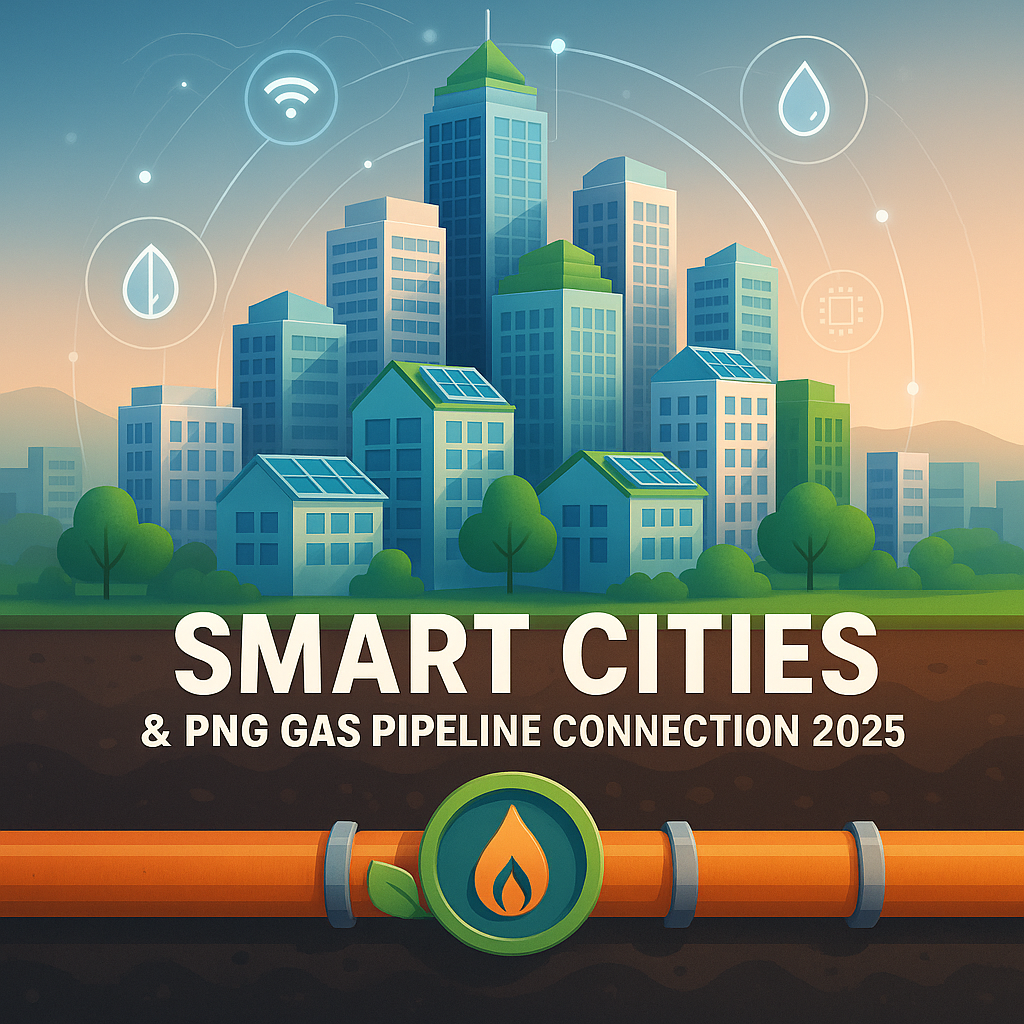PNG Gas Pipeline India’s urban landscape is undergoing a transformative shift, driven by the twin engines of the Smart Cities Mission and the expansive rollout of Piped Natural Gas -PNG Gas Pipeline infrastructure. As we navigate through 2025, these initiatives are not only redefining urban living but also steering the nation towards a sustainable and energy-efficient future. This article delves into the synergy between smart urban development and the proliferation of PNG connections, highlighting their collective impact on India’s socio-economic and environmental fabric.
🏙️ The Smart Cities Mission PNG Gas Pipeline : A Decade of Urban Transformation
Launched in 2015, the Smart Cities Mission aims to promote sustainable and inclusive cities that provide core infrastructure and give a decent quality of life to their citizens. As of January 2025, the mission has achieved significant milestones: PNG Gas Pipeline
-
Project Completion: Out of 8,058 tendered projects, 7,479 have been completed, utilizing ₹1,50,002 crores of the total tendered amount of ₹1,64,368 crores.
-
Technological Integration: Emphasis on digital governance, intelligent traffic management, and efficient waste management systems.
-
Citizen-Centric Services: Enhanced public services through e-governance and mobile applications.
These advancements have laid a robust foundation for integrating modern utilities like PNG into the urban ecosystem.
🔥 PNG Gas Pipeline : Fueling the Future of Urban India
Piped Natural Gas PNG Gas Pipeline offers a cleaner, safer, and more efficient alternative to traditional cooking fuels. Its integration into urban households aligns seamlessly with the objectives of the Smart Cities Mission.
📈 Growth Trajectory
-
Connection Expansion: PNG connections have surged from 2.5 million in 2014 to 12.1 million by March 2024, with plans to reach 125 million connections by 2030 .
-
Infrastructure Development: The operational gas pipeline network is set to expand by 10,805 km, augmenting the current 24,945 km .
-
City Gas Distribution (CGD): The CGD network now covers 733 districts across 34 states and union territories .
🌿 Environmental and Economic Benefits –
-
Reduced Emissions: PNG emits significantly less CO₂ compared to coal and oil, contributing to India’s commitment to net-zero emissions by 2070.
-
Cost Efficiency: PNG is more economical over time, eliminating the need for cylinder refills and reducing transportation costs.
-
Safety and Convenience: Continuous supply reduces the risk of gas leaks and the inconvenience of cylinder replacements.
🛠️ Infrastructure and Technological Advancements
The expansion of PNG infrastructure is bolstered by technological innovations and strategic investments:
-
Digital Monitoring: Integration of Geographic Information Systems (GIS) for real-time monitoring and maintenance of pipeline networks .
-
Green Energy Integration: Initiatives to blend Compressed Bio-Gas (CBG) into the PNG supply, promoting renewable energy usage .
-
Public-Private Partnerships: Collaboration between government bodies and private entities to accelerate infrastructure development and service delivery.
🏭 Impact on Commercial Sectors PNG Gas Pipeline
The proliferation of PNG connections extends beyond residential use, significantly impacting commercial and industrial sectors:
-
Commercial Kitchen Equipment: Businesses in the hospitality and food industry benefit from the consistent and efficient energy supply, enhancing operational efficiency. Companies like Parashar Infra specialize in providing state-of-the-art commercial kitchen equipment, aligning with the energy needs of modern establishments.
-
Industrial Applications: Industries leverage PNG for processes requiring consistent heat, improving product quality and reducing operational costs.
-
Transportation: Expansion of Compressed Natural Gas (CNG) stations, with plans to reach 25,000 stations by 2032, supports the transition to cleaner vehicular fuels .
🌐 Regional Development: Case Studies
🏞️ Northeast India
The government anticipates an investment of approximately $4.95 billion to develop natural gas pipeline infrastructure in the northeastern states and the northern federal territories of Kashmir and Ladakh. This initiative aims to distribute natural gas to small industries, automobiles, and households in five northeastern states and two northern union territories .
🛣️ Southern India
The Petroleum and Natural Gas Regulatory Board (PNGRB) has invited bids for the development of a 425-km Kochi-Kanyakumari-Thoothukudi natural gas pipeline. This project aims to boost energy infrastructure in southern India and link Petronet LNG Ltd.’s Kochi LNG terminal with Indian Oil Corporation Ltd.’s Ennore-Thoothukudi pipeline .
🚀 Future Outlook: Towards a Sustainable Urban India
The convergence of the Smart Cities Mission and PNG infrastructure development is poised to redefine urban living in India:
-
Enhanced Quality of Life: Access to clean energy, efficient public services, and improved infrastructure contributes to a higher standard of living.
-
Economic Growth: Infrastructure projects generate employment opportunities and stimulate local economies.
-
Environmental Sustainability: Reduced reliance on fossil fuels and integration of renewable energy sources align with global climate goals.
🔥 Why PNG is Growing Fast in 2025:
-
PNG is cleaner, safer, and cheaper than LPG.
-
India plans to expand to 125 million PNG connections by 2030.
-
Over 24,000 km of gas pipelines already exist, with thousands more being added.
-
The government supports PNG for households, vehicles (CNG), and industries.
🌍 How This Helps Smart Cities:
-
PNG supports clean energy goals (less pollution! 🌱).
-
Fewer gas cylinders = less traffic and carbon emissions.
-
Reliable gas = better commercial kitchen operations, like those supported by Commercial Kitchen Equipment.
💡 Real-World Impact:
-
Cities are safer and cleaner with PNG.
-
Restaurants and hotels are using PNG for faster, more efficient cooking.
-
Industries get a constant fuel supply, boosting productivity.
🚀 What to Expect Next:
-
Even rural and remote areas will get PNG.
-
PNG will blend with bio-gas and green hydrogen in the future.
-
PNG is key to India’s net-zero emissions goal by 2070.
📝 Conclusion
The integration of Piped Natural Gas into India’s urban framework exemplifies the nation’s commitment to sustainable development and energy efficiency. As cities evolve into smart urban centers, the synergy between technological innovation and infrastructure development will play a pivotal role in shaping a resilient and prosperous India.

